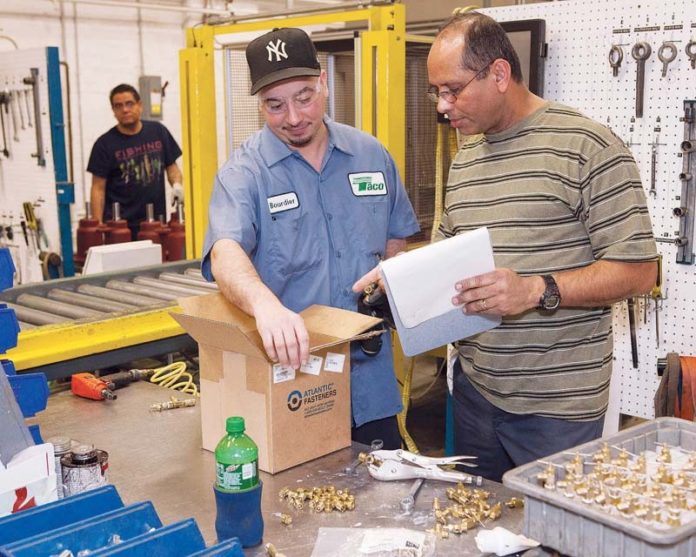
Steady improvement in manufacturing productivity could signal economic progress in 2014, advocates say, but investment in training is what’s needed most to propel the industry forward.
Total manufacturing hours improved for 10 months of 2013, compared with 2012, according to University of Rhode Island economist Leonard Lardaro’s Current Conditions Index. Percentage increases ranged from 0.4 to 3.8 percent – data that – given Rhode Island’s tie for the highest unemployment rate in the nation with Nevada at 9 percent – surprised Lardaro.
The index broadly measures momentum in the economy from month to month and year over year. Manufacturing hours, just one of 12 indicators, reflect the total number of hours worked as opposed to the number of employment positions, or jobs.
Since those hours worked have grown after falling precipitously during the recession, employees have returned to a more normal workweek, “so manufacturing has actually come back a bit,” Lardaro said in late December.
“Everything I’m hearing through the grapevine, everybody seems to be more positive, more optimistic, showing modest signs of improvement,” agreed Bill McCourt, executive director of the Rhode Island Manufacturing Association. “By and large, what people are seeing is gradual improvement. They’re starting to feel a little bit better, but there’s still a long way to go.”
There are an estimated 2,000 manufacturers in the state, according to McCourt.
Lardaro offered some context when evaluating the positive news: 1984 was the last year that manufacturing employment increased in Rhode Island. And the third quarter of 1987 was the last time Rhode Island actually functioned as a manufacturing-based economy.
“That’s the problem,” he explained: “We’ve been post-manufacturing for 26 years. It’s less forgiving than a manufacturing-based economy.”
Nonetheless, he added, with manufacturing hours on the rise, manufacturing output also has increased, and that’s good news – as far as it goes. As more sophisticated manufacturing equipment reduces the number of people needed to operate machinery and causes layoffs, it also requires new training that is not always available, which prevents companies from hiring and expanding, he said.
McCourt wants to counter this trend, and address seemingly small but pertinent issues that his members and other manufacturers believe have been holding back the industry. Coordination of training with high schools and the Community College of Rhode Island, coupled with more capital to put toward such programs, would show commitment to the industry, he said.
Another $1 million is paid to the state to administer the program, and if that money went to manufacturers, that would be a step in the right direction, McCourt said.
Other issues include being able to operate on Victory Day, a holiday only Rhode Island celebrates, or allowing manufacturers a federal deduction used as an incentive in other states for producing goods and services in the United States. Rhode Island eliminated the deduction in 2013 as it balanced the budget, McCourt says.
“The message we have been conveying to the [state] leadership is: the ultimate fix is continuing to make some modest improvements in a wide range of areas,” McCourt said. “At the end of the day, we’re still ranked last in business competitiveness. That’s real. We don’t need to be No. 1. We just need to be closer to the middle of the pack.”
Many manufacturers have taken it upon themselves to train workers.
Chenevert and Scot A. Jones, CEO of Groov-Pin Corp. in Smithfield, say internships and internal training help develop their workforce, but the state needs to foster educational development for not only high school and college students, but for displaced workers as well.
Jones and Chenevert are looking to Massachusetts, whose Manufacturing Extension Partnership, comparable to Rhode Island’s Manufacturing Extension Service, is making inroads in this area.
In Massachusetts, Ted Bauer, manager of workforce-development programs, said a nearly $4 million U.S. Department of Labor grant for the unemployed that his organization received in April 2012 has resulted in matriculation of 40 people who completed a total of 260 hours of training as computer numeric-controlled machine operators.
Another 600 hours of additional on-the-job training resulted in 26 credits per worker that can be put toward an associate degree program in manufacturing technology through the Quinsigamond Community College in Worcester.
Programs like that one are not fully developed yet in Rhode Island, McCourt said, but could evolve in the coming year. He could not say exactly how much money is needed, but acknowledged it is in the millions of dollars. Another potential program in development in Rhode Island involves apprenticeship for CNC machinists, he said.
“What we need to do here in Rhode Island is make sure we’re taking advantage of all the opportunities available to us,” he said.
RIMES will be restructured this year to include a relationship with University of Rhode Island’s Research Foundation, which could help with funding.
Taco Inc., which makes commercial and residential heating, ventilation and air conditioning equipment, is another firm that has found a solution internally, retraining many of its 470 employees through its learning center, revamped in 2012 as the Innovation and Development Center.
What the company may lack in job creation it makes up for in job preservation and increases in salary as workers move from operating manual equipment to running more sophisticated, automated machinery, said Chris Integlia, executive vice president for Taco Inc.’s residential division. Workers who earn more consume more goods and services, and tend to be more willing to stay put, he said.
“Because our average worker count has remained the same for a while, it doesn’t go down and up, but the nature of those jobs has changed,” Integlia said. “We’re not hiring more people: We’re making better jobs and protecting jobs. New job creation is not necessarily the solution.”
However, investing in manufacturing jobs would multiply each job by as many as three subsidiary jobs, Jones added, so finding grants and other funds to invest in the industry would pay off economically in the long run.
“The only thing we can do as owners is preach [about] the industry as viable for youth to … have a career path,” said Chenevert, who has talked to legislative leaders and gotten positive feedback so far. “And we’re interested in getting displaced workers trained, and veterans. [But] the state needs to make a determination: do you want to support manufacturing or do you want to be a service state and a tourist state?” •












